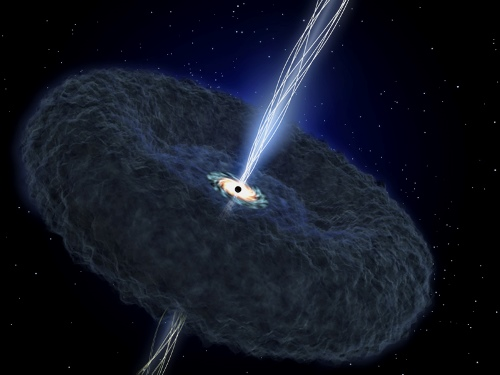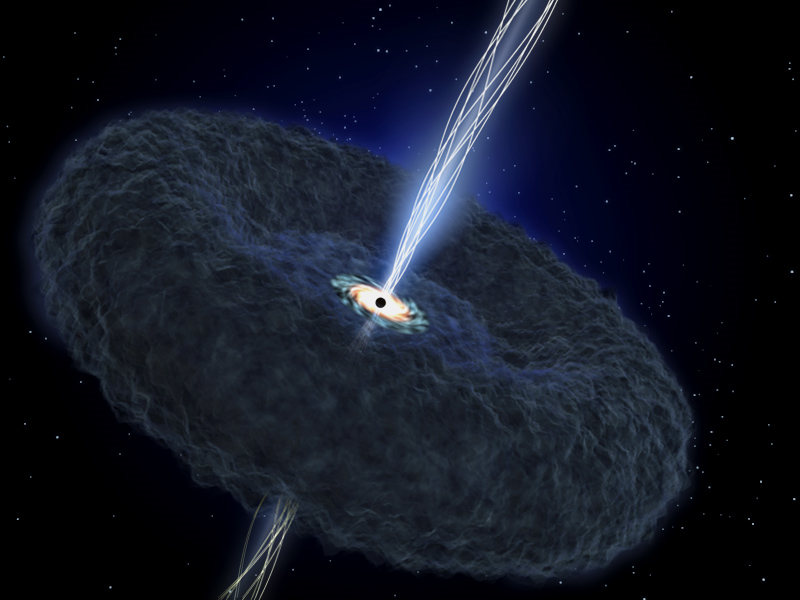Out of Neutron Star Rubble Comes Gold
Gold has long been appreciated for its beauty, its rareness, and a number of astonishing physical properties, like the fact that a single coin can be beaten into an area of more than 30 square meters. As much as gold has been searched for on Earth, there has been a long debate about its cosmic origin. But the detection this past summer of both gravitational waves and an electromagnetic flash from a neutron star merger (see 16 October 2017 Viewpoint) implies that heavy elements are forged around the most extreme objects in the Universe: neutron stars and black holes. A new theoretical study by Daniel Siegel and Brian Metzger from Columbia University, New York [1], simulates in detail the postmerger accretion of neutron star matter onto a black hole and confirms earlier, but less sophisticated, studies claiming that such systems are indeed promising production sites for gold and other heavy elements. The results may provide new insights into the recent neutron star merger observations, such as why the electromagnetic flash that accompanied the gravitational waves was so bright.
The heaviest elements are formed through the so-called “r process,” in which a nucleus grows larger by rapidly capturing multiple neutrons. Neutrons are favored over protons, whose positive charge repels them from the positively charged nucleus. After capturing a neutron, the nucleus is not generally stable. Instead, it may transform a neutron into a proton in a beta decay, thereby emitting an electron and an antineutrino. The next neutrons need to be captured on a very short time scale, before the next beta decays set in. This is the defining feature of the r process, and its basic workings were already understood in the late 1950s [2].
Although it’s clear what the r process needs—an explosion with lots of neutrons—where this actually happens has been a mystery for decades. The first suspected culprits were massive stars that explode as core-collapse supernovae. Later on, researchers developed an alternative r-process scenario involving mergers of neutron stars in binary systems, but this idea retained an “exotic” aura as such mergers had never been observed before. It is rather obvious that neutron stars would be an ideal place for the r process; after all, they consist predominantly of neutrons. Much less obvious is whether there is any way to eject the matter in the first place. A neutron star has an enormous gravitational pull, with a gravitational binding energy in excess of 100 MeV/nucleon. By comparison, the most energetic nuclear reactions release less than 10 MeV of energy per nucleon. So nuclear reactions would fall far short of liberating any matter from a neutron star surface. To rip a neutron star apart, it takes a merger with another extreme object, either a black hole [3] or another neutron star [4]. Besides being potential heavy element sources, these violent collisions were also predicted [4] to produce short gamma-ray bursts (GRBs), which are brief and enormously bright flashes of gamma rays.
In the late 1990s, computer simulations [5] showed that neutron star mergers can indeed eject a few percent of a solar mass when they come into contact, enough to explain a large fraction, if not all, of the observed r-process matter in the Milky Way. A companion study [6] demonstrated that these “dynamic ejecta” forge a broad range of heavy elements up to and beyond gold and platinum. More recently, researchers have identified additional ejection channels, including “neutrino-driven winds” [7] and the unbinding of a torus of accreting matter [8, 9] in the aftermath of a merger. This latter scenario of torus unbinding is the focus of Siegel and Metzger’s work.
An accretion torus is a natural consequence of the merger of two neutron stars or of a black hole and a neutron star (see Fig. 1). The torus contains neutron star debris, a portion of which is destined to fall into the central spinning black hole that emerges from the coalescence. Since neutron stars often have strong magnetic fields, the torus is endowed from its beginning with a seed field. The rotation profile—in which the inner parts spin faster than the periphery—makes the torus prone to a “magnetorotational instability” (MRI) that amplifies the seed field, drives the torus into a turbulent state, redistributes its angular momentum, and leads to continued draining of the neutron star matter into the hole. While the occurrence of the instability can be demonstrated analytically, following its detailed growth has proven to be a serious challenge for computer simulations because very small length scales need to be resolved. As such, previous attempts have often relied on “effective models” that treat the effect of the MRI as a single viscosity parameter.
Siegel and Metzger [1] performed three-dimensional relativistic magnetohydrodynamics simulations of such a black hole torus system. Since the torus is very dense ( ∼1010g/cm3) it emits large amounts of neutrinos while trapping photons. The weak interactions that produce the neutrinos can also change the neutron-to-proton ratio in the torus. Contrary to earlier studies, Siegel and Metzger calculated both relativistic effects and the dissipation inside the torus from first principles rather than via effective models. The new results show how the magnetic fields grow—first by winding through rotational motion, then via the MRI—and how the neutron-to-proton ratio evolves in the torus. Interestingly, the MRI-driven flow manages to eject a significant fraction (over 20%) of the initial torus mass into space. With neutron-to-proton ratios between 3 and 10, the ejecta produce a range of heavy r-process material with a pattern similar to what is observed in the solar system. This is consistent with previous studies, but the predictions are more trustworthy as they are obtained from first principles.
Until very recently, the idea that neutron star mergers produce heavy elements—as well as GRBs and gravitational waves—was supported only by indirect evidence. This changed on August 17, 2017, when researchers detected, for the first time, the gravitational-wave “chirp” from a neutron star merger. This signature was followed 1.7 s later by a GRB and subsequently by a slew of transient signals across the electromagnetic spectrum [10], as expected from the decay of freshly forged r-process elements. The long-awaited era of “multimessenger” astrophysics had finally become a reality.
The gravitational-wave window to the Universe has only just opened up and already we have conclusive answers to long-standing puzzles, such as the connection between neutron star mergers and r-process nucleosynthesis. But very soon we may receive answers to questions that we have not yet asked. Therefore, it is crucial that our theoretical models keep up with the observational pace. The new study by Siegel and Metzger is an important element in solidifying our understanding of the physics of multimessenger sources. The authors’ result that a large fraction of the accreting torus escapes the final black hole’s pull may explain why the first observed multimessenger event was so bright in electromagnetic waves. Whether it was typical or “just” an extreme outlier can only be answered after more such detections. We eagerly await the excitement the next “nuggets” will bring.
This research is published in Physical Review Letters.
References
- D. Siegel and B. D. Metzger, “Three-Dimensional GRMHD Simulations of the Remnant Accretion Disks from Neutron Star Mergers: Outflows and r-Process Nucleosynthesis,” Phys. Rev. Lett. 119, 231102 (2017).
- E. M. Burbidge, G. R. Burbidge, W. A. Fowler, and F. Hoyle, “Synthesis of the Elements in Stars,” Rev. Mod. Phys 29, 547 (1957).
- J. M. Lattimer and D. N. Schramm, “Black-Hole-Neutron-Star Collisions,” Astrophys. J 192, L145 (1974).
- D. Eichler, M. Livio, T, Piran, and D. N. Schramm, “Nucleosynthesis, Neutrino Bursts and 𝛾-Rays from Coalescing Neutron Stars,” Nature 340, 126 (1989).
- S. Rosswog, M. Liebendörfer, F.-K. Thielemann, M. B. Davies, W. Benz, and T. Piran, “Mass Ejection in Neutron Star Mergers,” Astron. Astrophys. 341, 499 (1999).
- C. Freiburghaus, S. Rosswog, and F.-K. Thielemann, “r-Process in Neutron Star Mergers,” Astrophys. J. Lett. 525, L121 (1999).
- A. Perego, S. Rosswog, R. M. Cabezon, O. Korobkin, R. Kappeli, A. Arcones, and M. Liebendorfer, “Neutrino-Driven Winds from Neutron Star Merger Remnants,” Mon. Not. R. Astron. Soc. 443, 3134 (2014).
- R. Fernández and B. D. Metzger, “Delayed Outflows from Black Hole Accretion Tori Following Neutron Star Binary Coalescence,” Mon. Not. R. Astron. Soc. 435, 502 (2013).
- O. Just, A. Bauswein, R. Ardevol Pulpillo, S. Goriely, and H.-T. Janka, “Comprehensive Nucleosynthesis Analysis for Ejecta of Compact Binary Mergers,” Mon. Not. R. Astron. Soc. 448, 541 (2015).
- B. P. Abbott et al., “Multi-messenger Observations of a Binary Neutron Star Merger,” Astrophys. J. Lett. 848, 12 (2017).





